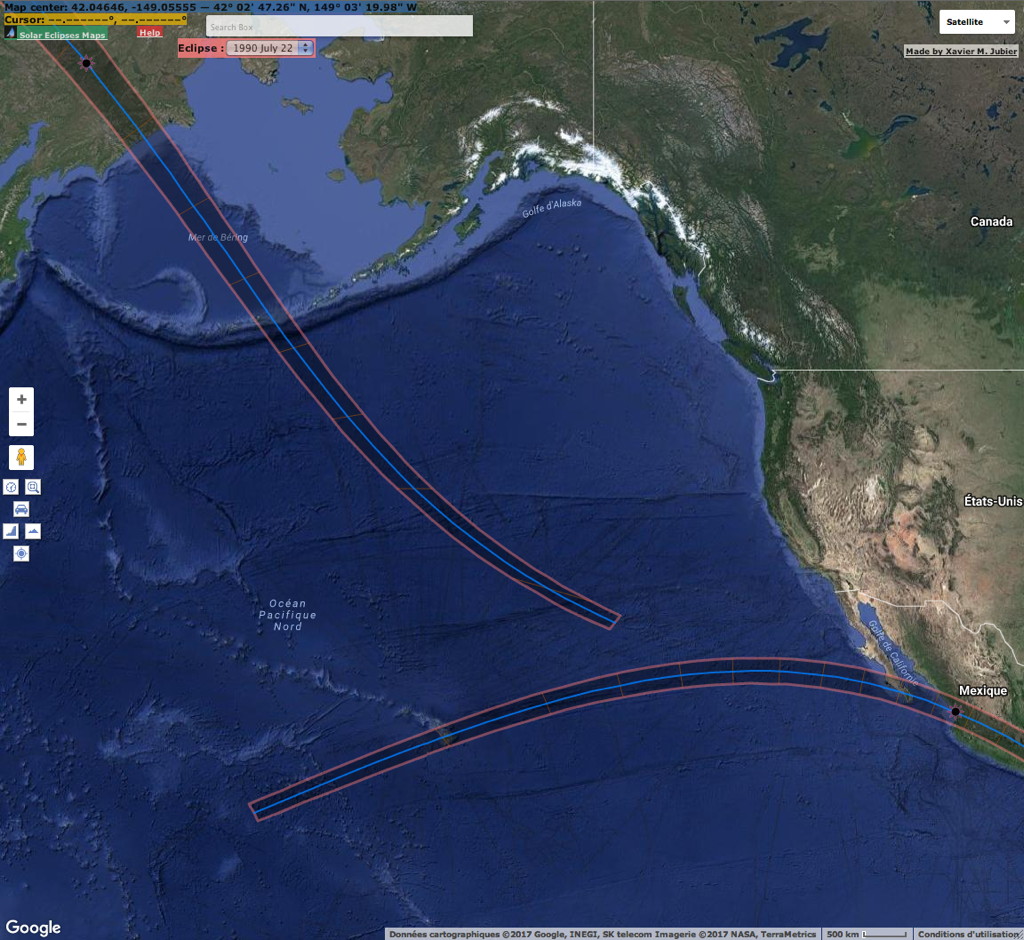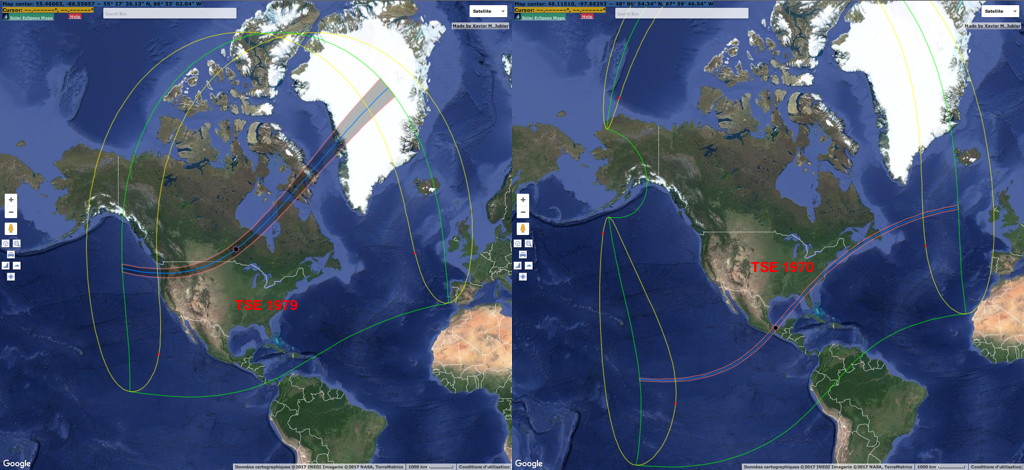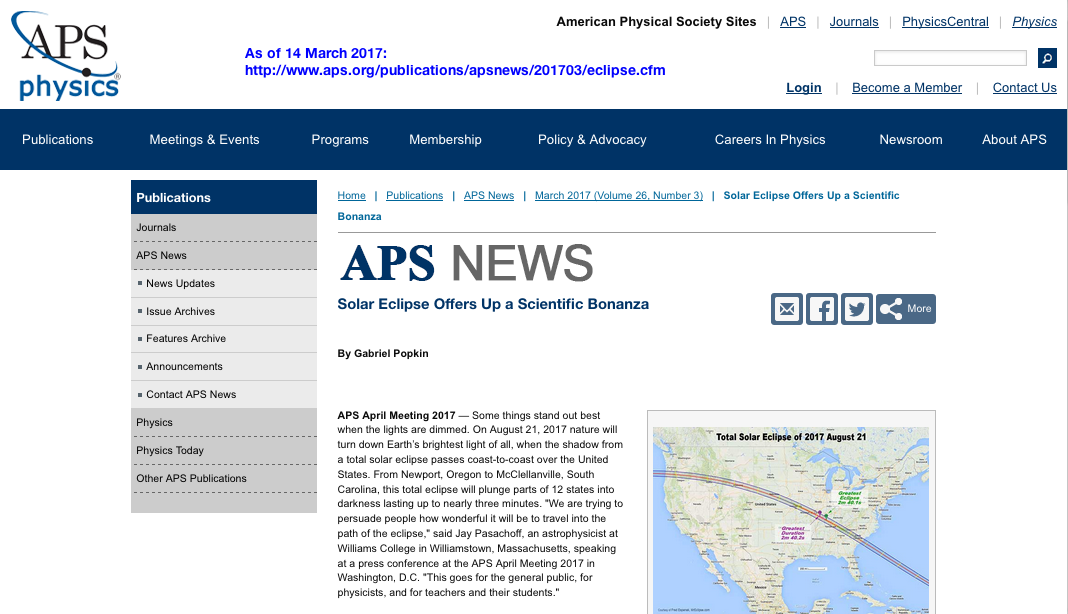
|
Total Solar Eclipse of 2017 August 21
Fact-check on Official and Authoritative Assertions
#eclipse2017, #tse2017, #2017eclipse
|

|
|
|
Some official sources, for example NASA and USNO, certify, or at least let you think, that the path of totality for this total solar eclipse will only pass through 12 or 13 states: this is inaccurate at best. Indeed this eclipse path crosses 14 states:
             
More details…
Now lets do some more fact-checking on the veracity of official and authoritative assertions.
|
|
|
|
NASA
In January 2017 this is what you could read on the "Eclipse 2017 NASA" website at the following URL http://eclipse2017.nasa.gov/maps-cartography (see screenshot to keep a record). Weeks after I pointed this out and as of February 2017 the false or misleading information have been completely removed rather than just fixing it! Is this the new trend we’re seeing elsewhere… ;-)

Ok, lets analyze those assertions one by one to see what is going on.
"In the 35 years from 1981 to 2016, there have been no total solar eclipse over the U.S.."
This assertion is misleading at best.
Where does this 1981 year come from? Maybe to have an identical time span with the next assertion?
Are they talking about the continental USA or not (likely not since on the fifth assertion "continental" is specified), because there were a TSE over Alaska (Aleutian Islands) in 1990 and another total over Hawaii in 1991 as seen on this map:

"Between 1776 and 2017, Montana and Idaho have seen the most total solar eclipses with six events each during this time."
This assertion is plain wrong.
Indeed Montana saw eight TSEs, one of them —1930 April 28th— being a beaded total. Idaho saw six TSEs, among which 1930 April 28th is the beaded total previously mentioned. The 1930 hybrid solar eclipse was in fact never really total anywhere along its path as there was no complete photospheric extinction. In 2017 the total solar eclipse central path will cross both Idaho and Montana.
In reality, Montana is the undisputed champion and will retain its crown even after TSE 2017; moreover Montana will even increase its lead in 2044 and 2099.
Here is the proof for Montana:

And now for Idaho:

"This eclipse will be the first since 1979 to be visible within the 50 states."
This new assertion is wrong.
Indeed Hawaii didn’t experience any eclipse in 1979! So you have to go back to TSE 1970 to find the correct answer.

"During the last 1,000 years, 98% of the locations across the continental U.S. have been able to view a total solar eclipse."
Only true if TSE 2017 is included.
The following map says it all:

"The total solar eclipse appears in 12 states: Oregon, Idaho, Wyoming, Nebraska, Kansas, Missouri, Illinois, Kentucky, Tennessee, North Carolina, Georgia, and South Carolina."
Again this assertion is wrong.
Why did NASA omit Montana and Iowa which both unequivocally will experience totality?
Some may argue that the centerline doesn’t go through those two states, nevertheless it doesn’t disqualify Montana and Iowa to be part of the list. Moreover not adding them creates a two-class citizen conundrum because then how can they justify statistics such as point number 6? Well they simply can’t. An eclipse experience is not all about duration or centerline, there is much more to it.


Huh, did I miss something? In short, huge approximations to muddy the waters and confuse the population! Not great to do public outreach. So who is to blame, the people who didn’t do their homework properly or the manager?
Another question: from which sources those assertions have been derived? This should clearly be stated and unfortunately it isn’t…
Another example: in January 2017 this is also what you could read on the "Total Solar Eclipse 2017 NASA Resources for Informal Education | Museum Alliance" webpage at the following URL http://informal.jpl.nasa.gov/museum/content/eclipse-2017 (see screenshot to keep a record).

I’d say NASA can hopefully do better to inform the public properly!
"crossing the USA from west to east through parts of Oregon, Idaho, Montana, Wyoming, Nebraska, Kansas, Missouri, Illinois, Kentucky, Tennessee, North Carolina, Georgia, and South Carolina."
Strangely Montana is listed as one of the states over which the umbral shadow cone will pass, nevertheless Iowa is absent… What is going on? It doesn’t make sense at all, as I have already shown 14 states will be visited by the lunar shadow. So in one place NASA says only 12 states, in another 13 states, all wrong… and no consistency. Who’s in charge?
"Considering the national and international coverage this event will likely have, especially from NASA itself, the best place to see the eclipse is wherever you are!"
This sentence is confusing at best, even with what is being said just before. First, this isn’t the best way to promote a day trip to the central eclipse path in order to get the real experience. Second, what does this have to do with the amount of national and international media coverage? Third, taking it to the letter here is my take: Good to know, so maybe I should stay home (southwest of Paris, France) for once as I will still have access to an extremely small partial, about 2 percent, at sunset for only a couple of minutes ;-) As first contact is already very low over the western horizon, I’m not even sure to see it because of the hills and trees to the west of my position ;-) And even better I can even do it all the way naked eye, no need for any solar eclipse glasses or filters, wohooo thanks NASA for the useful advice!
No kidding! My educated heartfelt recommendation is: try your best to make it to the central eclipse path and take the opportunity to experience totality and you will be rewarded for your effort.
|
USNO
In January 2017 this is what you could read on the "Eclipse 2017 USNO" website at the following URL http://aa.usno.navy.mil/data/docs/Eclipse2017.php.

Ok, lets analyze those assertions one by one to see what is going on.
"On 2017 August 21, a total solar eclipse will be visible to fortunate observers in the United States along a narrow band, approximately 73 miles (118 km) wide, that crosses twelve states from Oregon to South Carolina."
This assertion is misleading at best.
Why did the US Naval Observatory omit Montana and Iowa which both unequivocally will experience totality?
Some may argue that the centerline doesn’t go through those two states, nevertheless it doesn’t disqualify Montana and Iowa to be part of the list. Again an eclipse experience is not all about duration or centerline, there is much more to it.


Also at its widest point the central eclipse path is only about 71 miles (115 km) wide, so an error of about 2%.
Again what to say other than the correct information is not provided to the public. Why is that?
Is this the way indisputable facts are going to be reported by morphing them into the new political ordeal… ;-)
|
APS
In March 2017 this is what you could read on the "APS News" webpage at the following URL http://www.aps.org/publications/apsnews/201703/eclipse.cfm (see screenshot to keep a record). Again misleading information by an official source… :-(

Ok, lets see what is going on.
"this total eclipse will plunge parts of 12 states into darkness lasting up to nearly three minutes."
As I already said this assertion is wrong or at best misleading.
Omitting Montana and Iowa which both unequivocally will experience totality doesn’t make sense.
Then the nearly "three minutes" is a bit too much as on average it will be about than 2 minutes and 20 seconds with a maximum of about 2 minutes and 40 seconds. Bigger or longer is not necessarily better…
Last it would be nice if our Sun was properly capitalized as it should be: "Like all proper nouns, the names of moons, stars, and planets are written with capital letters."


|
|
|
|
|
|
|


























